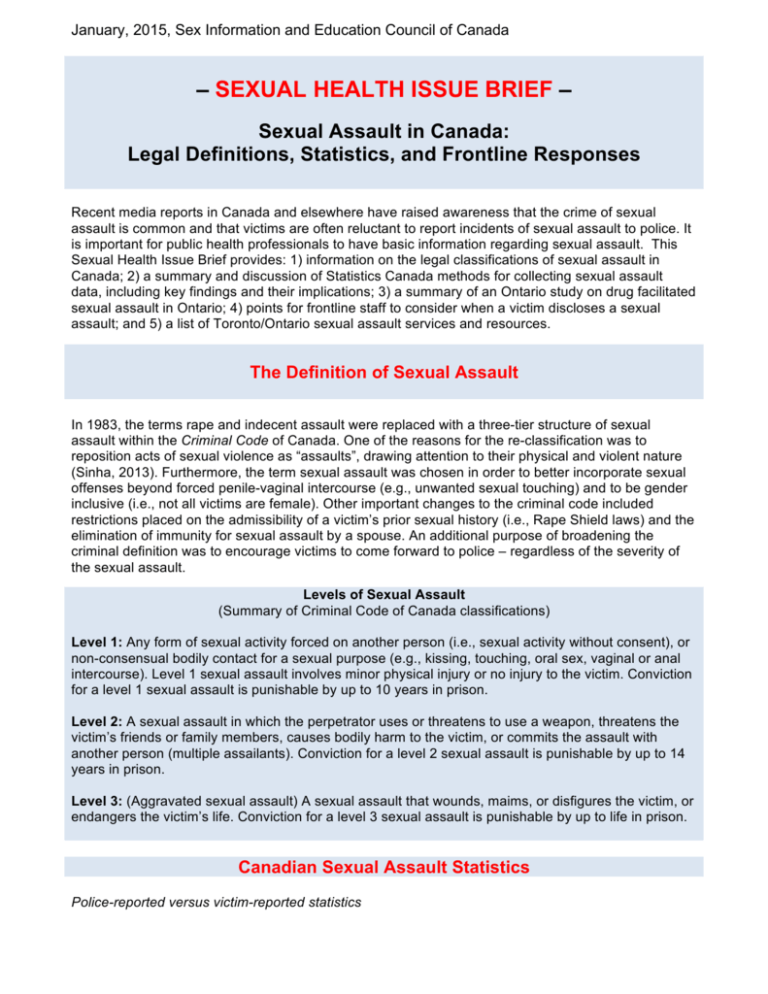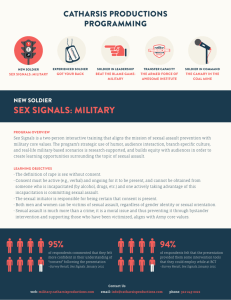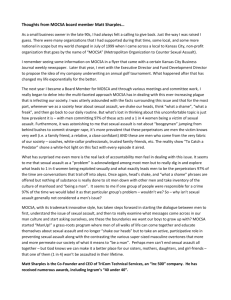
January, 2015, Sex Information and Education Council of Canada
– SEXUAL HEALTH ISSUE BRIEF –
Sexual Assault in Canada:
Legal Definitions, Statistics, and Frontline Responses
Recent media reports in Canada and elsewhere have raised awareness that the crime of sexual
assault is common and that victims are often reluctant to report incidents of sexual assault to police. It
is important for public health professionals to have basic information regarding sexual assault. This
Sexual Health Issue Brief provides: 1) information on the legal classifications of sexual assault in
Canada; 2) a summary and discussion of Statistics Canada methods for collecting sexual assault
data, including key findings and their implications; 3) a summary of an Ontario study on drug facilitated
sexual assault in Ontario; 4) points for frontline staff to consider when a victim discloses a sexual
assault; and 5) a list of Toronto/Ontario sexual assault services and resources.
The Definition of Sexual Assault
In 1983, the terms rape and indecent assault were replaced with a three-tier structure of sexual
assault within the Criminal Code of Canada. One of the reasons for the re-classification was to
reposition acts of sexual violence as “assaults”, drawing attention to their physical and violent nature
(Sinha, 2013). Furthermore, the term sexual assault was chosen in order to better incorporate sexual
offenses beyond forced penile-vaginal intercourse (e.g., unwanted sexual touching) and to be gender
inclusive (i.e., not all victims are female). Other important changes to the criminal code included
restrictions placed on the admissibility of a victim’s prior sexual history (i.e., Rape Shield laws) and the
elimination of immunity for sexual assault by a spouse. An additional purpose of broadening the
criminal definition was to encourage victims to come forward to police – regardless of the severity of
the sexual assault.
Levels of Sexual Assault
(Summary of Criminal Code of Canada classifications)
Level 1: Any form of sexual activity forced on another person (i.e., sexual activity without consent), or
non-consensual bodily contact for a sexual purpose (e.g., kissing, touching, oral sex, vaginal or anal
intercourse). Level 1 sexual assault involves minor physical injury or no injury to the victim. Conviction
for a level 1 sexual assault is punishable by up to 10 years in prison.
Level 2: A sexual assault in which the perpetrator uses or threatens to use a weapon, threatens the
victim’s friends or family members, causes bodily harm to the victim, or commits the assault with
another person (multiple assailants). Conviction for a level 2 sexual assault is punishable by up to 14
years in prison.
Level 3: (Aggravated sexual assault) A sexual assault that wounds, maims, or disfigures the victim, or
endangers the victim’s life. Conviction for a level 3 sexual assault is punishable by up to life in prison.
Canadian Sexual Assault Statistics
Police-reported versus victim-reported statistics
2
Assessing the true prevalence of sexual assault in Canada is difficult due to the different ways that
sexual assault data is collected. Statistics Canada relies on two data sources to track the incidence of
sexual assault—the Uniform Crime Reporting (UCR) Survey and the General Social Survey (GSS),
which includes data on victimization. The UCR survey tracks the number of sexual assaults reported
to police, and the GSS asks Canadians whether they’ve been victims of sexual assault, including
assaults they may not have reported to police.
According to data from the UCR, in Canada, in 2013, there were approximately 21,300 sexual
assaults reported to the police, 98% of which were classified as Level 1. In the same year, there were
7,677 police reported sexual assaults in the province of Ontario. In both Ontario and Canada
generally, the rate of police reported sexual assaults declined by 4% from 2012 to 2013 (Boyce,
Cotter, & Perreault, 2014).
The GSS, on the other hand, which is conducted at 5-year intervals (a new GSS report will likely be
published in 2015) uses a different method of data collection. It calculates self-reported crime rates by
asking a nationally representative sample of 15-and-older Canadians whether they’ve been victims of
various types of crime during the previous 12 months. Overall, the GSS results for sexual assault were
similar in 1999, 2004, and 2009.
For 2009, the most recent year for which GSS data is available, there were approximately 677, 000
incidents of sexual assault in Canada, or 24 incidents per 1000 people who were 15 and older
(Perreault & Brennan, 2010). For 472, 000 (70% of the total) of these sexual assaults, the victim was
female and 87% of perpetrators were male. Most (81%) involved unwanted sexual touching, grabbing,
kissing, or fondling (i.e., generally corresponding to Level 1 sexual assault) while about one in five
involved more serious sexual attacks. In more than half (58%) of 2009 sexual assaults, the
perpetrators were friends, acquaintances, or neighbours of the victims.
Aside from the statistics related to the gender of victims, there is limited information within the GSS on
the demographic characteristics of sexual assault victims. Sexual assault rates were almost twice as
high for 15- to 24-year-olds as for 25- to 34-year-olds, and many times higher than for people who
were 35 and older. People who identified as single or as students had higher rates of sexual assault.
Sexual assault victimization rates did not differ significantly based on household income. Aboriginal
people experienced higher rates of sexual assault compared to non-aboriginal people (Perreault &
Brennan, 2010). The GSS information reported by Statistics Canada does not include sexual assault
rates of people with non-heterosexual orientations and does not include a transgender identity
category.
As the URC survey and GSS statistics show, there’s a large difference between the number of sexual
assaults reported to police and the number that actually take place. Although the two surveys define
sexual assault in slightly different ways, making direct comparisons difficult, researchers estimate that
only about one in 10 sexual assaults in Canada is reported to the police (Brennan & Taylor-Butts,
2008).
Why Are So Many Sexual Assaults Not Reported To Police?
Common reasons for not reporting a sexual assault to police
According to the GSS victimization data (Brennan & Taylor-Butts, 2008), the most common reason
victims of sexual assault gave for not reporting an incident to police was because they felt it was not
important enough (58%), followed by the incident was dealt with in another way (54%). Other common
reasons given were that it was a personal matter (47%) and that the victim did not want to get involved
with the police (41%). Situational variables may result in women not wanting to report the activity to
3
the police. For example, in 2009, 51% of cases involved a current or previous intimate partner or
acquaintance/friend (Perrault & Brennan, 2010). Research has found that having a prior relationship
with the assailant is associated with a reduced likelihood that the victim will report the assault to the
police (Jones, Alexander, Wynn, Rossman, & Dunnuck, 2009).
In a national study of female rape victims in the United States, among those who did not report the
assault to police, the main reasons given by women for not reporting were the fear of reprisal (68.1%),
not wanting family to know (59.1%), not wanting others to know (57.4%), believing that there was not
enough evidence to file charges (51.1%), and fear of the justice system (42.6%) (Wolitzky-Taylor,
Resnick, McCauley, Amstadter, Kilpatrick, & Ruggiero, 2011).
It has been suggested that one reason women do not report sexual assault to the police stems from a
belief among victims that the police will not take their report seriously. Long-held rape myths in
Western culture mean some women may believe they will face skepticism regarding whether or not
they resisted strenuously enough or that authorities will be less inclined to investigate if the perpetrator
is a dating partner or husband (Johnson, 2012).
Only a small percentage of sexual assaults reported to police result in a conviction
A fundamental reason why many women may choose not to report a sexual assault to police is that
that the probability that the complaint will eventually result in a criminal conviction is low. Using data
from the 2004 GSS, Johnson (2012) has shown that only a small proportion of sexual assaults
reported to police by women result in a conviction (See Figure 1).
Conviction 1,519 (10.0%) Prosecuted 2,824 (18.6%) Charges laid 5,544 (36.5%) Recorded as a crime 13,200 (86.8%) 2004 GSS number sexual assaults of women reported to police 15,200 Figure 1: Percentage of sexual assaults of women reported to police resulting in criminal conviction
Source: Adapted from Johnson, H. (2012). Limits of a criminal justice response: Trends in police and court
processing of sexual assault. In. E. Sheehy (Ed.) Sexual Assault in Canada: Law, Legal Practice, and Women’s
Activism (pp. 613-634). Ottawa, ON: University of Ottawa Press.
If a sexual assault is reported to police they have a duty to investigate. Upon investigation, the police
may decide that the report is “unfounded” – meaning that there is not enough evidence to pursue any
further investigation (Johnson, 2012). Research has found that reports of sexual assault are more
likely to be deemed as unfounded compared to investigation of other types of crime (Roberts,
Johnson, & Grossman, 2003). If charges are laid, they may be dropped for a number of reasons
4
including that the victim chooses not to proceed or the police conclude that they do not have
“reasonable grounds” to pursue a charge or it is concluded that the evidence is insufficient to obtain a
conviction (Johnson). As Figure 1 indicates, only about half of sexual assault charges result in a
criminal prosecution. In addition, as the Figure also illustrates, in 2004, just over half of sexual assault
prosecutions resulted in a conviction. More recent Statistics Canada (2014) data indicate that in 20112012, 41% of sexual assault cases brought to court resulted in a guilty decision and the corresponding
figure for Ontario was 35%.
Police Records Likely Under-Report the Severity of Many Sexual Assaults
As noted above, of sexual assaults substantiated and reported by Canadian police services in the
UCR, 98% were recorded as level 1in 2013 (Boyce, Cotter, & Perreault, 2014). As Johnson (2012)
points out, since the three-tiered sexual assault classification replaced rape in the criminal code in
1983 the proportion of all reported sexual assaults that were recorded as the least severe level 1 has
increased (88%/1983 vs. 98%/2013). This could indicate that the proportion of all sexual assaults that
involve weapons and physical violence causing physical injury to the victim is decreasing.
Other data, however, suggest that this may not be the case and point to another explanation for the
relative decline in the proportion of sexual assaults recorded by police that are more severe compared
to level 1 sexual assaults. Participants in the self-report GSS indicate that they are more likely to
report a sexual assault to police if it involves a more severe physically violent sexual attack. It is
noteworthy that while the proportion of sexual assaults recorded by police as level 2 or 3 has been
declining, the percentage of victims in the GSS who reported that their sexual assaults involved the
use of threats or physical violence remained unchanged at 19% in 2004 and 2009 ((Brennan & TaylorButts, 2008; Perrault & Brennan, 2010). In an analysis of 2007 Revised Uniform Crime Reporting
Survey, Johnson (2012) found that, of sexual assaults classified as level 1, 2% involved the use of a
weapon, such as a firearm, knife, or blunt object and 17% resulted in physical injury. In other words,
these findings suggest that about a fifth of sexual assaults that were classified as level 1may have
been more appropriately been classified as level 2 sexual assaults.
Drug Facilitated Sexual Assault
Drug facilitated sexual assault can be defined as an offense in which victims are subjected to nonconsensual sexual activity while they are incapacitated or unconscious due to the effects of alcohol
and/or drugs and are therefore unable to resist or give consent (Hall, 2008). Although reports and
public awareness of drug facilitated sexual assault have increased in recent years, only a few studies
have sought to precisely determine the percentage of sexual assaults that involve drug facilitation and
the types of drugs used.
Du Mont and colleagues (2009, 2010) investigated possible drug facilitated sexual assault among 882
people (97% female) presenting to hospital-based sexual assault centres in Ontario. Participants were
designated as having been victims of drug facilitated sexual assault if they reported a suspicion of
having been drugged in combination with 1 or more of 16 associated symptoms (e.g., total or
complete amnesia, loss of consciousness, paralysis, confusion, drowsiness). Using these criteria,
20.9% of the sexual assaults were designated as drug facilitated (Du Mont et al., 2009). The most
common substances detected in toxicology screening of participants were alcohol (30.9%) (Alcohol
but no other drugs were present in 12.9% of cases), cannabis (33.7%), cocaine (21.4%),
amphetamines (7.3%), and MDMA (7.3%). Anti-anxiety medication (lorazepam) was found in 6.2% of
cases and the antidepressant citalopram in 6.7%. Ketamine and GBH were each found in 1.1% of
cases. Flunitrazepam (Rohypnol®) which is often thought to be a drug commonly used in drug
facilitated sexual assault was not found in any of the cases (Du Mont et al., 2010).
5
The findings of the Du Mont et al (2009, 2010) research suggests that approximately a fifth of sexual
assaults are drug facilitated and that there are a variety of drugs, including alcohol, used by
perpetrators to incapacitate their victims.
Frontline Responses to Sexual Assault
Due to the high prevalence of sexual assault, frontline public health professionals may encounter
clients who have been victimized. Frontline staff can play an important role as an initial confidante
and/or individual support system, especially for victims who choose to not report an assault to law
enforcement.
The Ontario Coalition of Rape Crisis Centres (http://www.sexualassaultsupport.ca) provides a range of
suggestions for supporting individuals who disclose that they have been sexually assaulted. These
include:
•
•
•
•
•
•
•
•
Protect the client’s confidentiality and inform them that you will do so.
Do not conduct an “investigation”. Accept and believe what the client discloses.
Listen emphatically and non-judgmentally.
Tell the client that that a sexual assault is never the victim’s fault.
Do not give personal advice (e.g., “If I were you, I would….”).
Do not call the police against the victim’s wishes (unless you are specifically mandated to do
so).
Suggest options for action (e.g., legal, counselling, and other support; see below) but let the
client decide what action to take.
Encourage the client to seek medical help including testing for unplanned pregnancy, HIV and
other STI.
Being aware of the sexual assault services in the community that victims can access is especially
helpful (See below). The Toronto Police/Victim Services Guide for Sexual Assault survivors (see link
below) provides information about the criminal justice system for victims who are making a decision
about reporting the assault to police.
Ontario/ Toronto Area Sexual Assault Services and Resources
§
Toronto Police/Victim Services. A Guide for Sexual Assault Survivors.
http://www.torontopolice.on.ca/publications/files/a_guide_for_sexual_assault_survivors.pdf
§
Toronto Rape Crisis Centre/Multicultural Women Against Rape. 24-hour crisis line: 416-5978808 www.trccmwar.ca
§
Ontario-wide: Assaulted Women’s Helpline 1-866-873-0511 (If assaulted in last 72 hours =
416-323-6040)
§
Women’s College Hospital Sexual Assault and Domestic Violence Care Centre. 416-323-6040
§
Scarborough Hospital Sexual Assault/Domestic Violence Care Centre. 416-495-2555
§
Peel Region Sexual Assault/Domestic Violence Program. 905-848-7580. X2142
§
Richmond Hill Domestic Abuse and Sexual Assault Care Centre. 1-800-521-6004
§
Durham Region Domestic Violence/Sexual Assault Centre. 905-571-3344 x116
6
References
Brennan, S., & Taylor-Butts, A. (2008). Sexual assault in Canada 2004 and 2007. Canadian Centre for Justice
Statistics Profile Series, 19, 1-20. http://www.statcan.gc.ca/pub/85f0033m/85f0033m2008019-eng.pdf
Boyce, J., Cotter, A., & Perreault, S. (2014). Police reported crime statistics in Canada, 2013. Juristat. Statistics
Canada catalogue no. 85-002-x http://www.statcan.gc.ca/pub/85-002-x/2014001/article/14040-eng.pdf
Du Mont, J., Macdonald, S., Rotbard, N., Asllani, E., Bainbridge, D., & Cohen, M. (2009). Factors associated
with suspected drug-facilitated sexual assault. Canadian Medical Association Journal, 180, (5), 513-519.
Du Mont, J., Macdonald, S., Rotbard, N., Bainbridge, D., Asllani, E., Smith, N., & Cohen, M. (2010). Drugfacilitated sexual assault in Ontario, Canada: Toxicological and DNA findings. Journal of Forensic and Legal
Medicine, 17, 333-338.
Hall, J.A. (2008). Drug facilitated sexual assault – A review. Journal of Forensic and Legal Medicine, 15, (5),
291-297.
Jones, J.S., Alexander, C., Wynn, B.N., Rossman, L. & Dunnuck, C. (2009). Why women don’t report sexual
assault to the police: the influence of psychosocial variables and traumatic injury. Journal of Emergency
Medicine, 36 (4), 417-424.
Johnson, H. (2012). Limits of a criminal justice response: Trends in police and court processing of sexual
assault. In. E. Sheehy (Ed.) Sexual Assault in Canada: Law, Legal Practice, and Women’s Activism (pp. 613634). Ottawa, ON: University of Ottawa Press.
Perreault, S., & Brennan, S. (2010). Criminal victimization in Canada, 2009. Juristat, 30, 1-29.
http://www.statcan.gc.ca/pub/85-002-x/2010002/article/11340-eng.pdf
Roberts, J., Johnson, H., & Grossman, M. (2003). Trends in crimes of sexual aggression in Canada: An analysis
of police-reported and victimization statistics. International Journal of Comparative Criminology, 18, 187-200.
Sinha, M. (2013). Measuring violence against women: Statistical Trends. Canadian Centre for Justice Statistics
Profile Series, no. 85-002-X. http://www.statcan.gc.ca/pub/85-002-x/2013001/article/11766-eng.pdf
Statistics Canada. (2014). Adult criminal courts, number of cases and charges by type of decision. CANSIM
Table 252-0053.
http://www5.statcan.gc.ca/cansim/a05?lang=eng&id=2520053&pattern=2520053&searchTypeByValue=1&p2=3
5
Wolitzky-Taylor, K.B., Resnick, H.S., McCauley, J.L., Amstader, A.B., Kilpatrick, D.G., & Ruggiero, K.J. (2011).
Is reporting of rape on the rise? A comparison of women with reported versus unreported rape experiences in
the National Women’s Health Study replication. Journal of Interpersonal Violence, 26 (4), 807-832.
This Sexual Health Issue Brief was
prepared for City of Toronto Public
Health by the Sex Information and
Education Council of Canada
(SIECCAN): 416-466-5304;
www.sieccan.org; sieccan@web.ca





